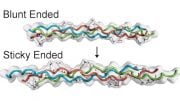
Study participants had a choice between the certain gain of $5 and taking a risk with a bag of chips representing different amounts and probabilities. (Photo by Michael S. Helfenbein)
New research from Yale University and NYU reveals that older adults are less inclined to take risks due to changes in brain anatomy rather than age. The finding adds to scientific understanding of decision making and may lead to strategies for modifying changes in risk behavior as people age.
Research has demonstrated that older adults are less inclined to take certain types of risks, such as participating in a lottery. In a prior study, associate professor of comparative medicine and neuroscience Ifat Levy and colleagues documented a link between tolerance for taking risks and gray matter volume in an area in the back of the brain known as the posterior parietal cortex; the more gray matter young adults had, the more likely they were to take risks.
In the new study, Levy and her co-authors, including first author Michael Grubb, a former NYU postdoc and currently at Trinity College, examined the phenomenon in older adults, who experience a natural decline in gray matter volume with age. The research team studied whether changes in gray matter volume in the posterior parietal cortex, or aging itself, accounted for older adults’ tendency to avoid risk.
For the study, the research team presented a series of choices to 52 study participants, aged 18 to 88 years Participants could either receive $5 or take their chances with a lottery of varying amounts and probabilities. For example, a participant could choose the certain gain of $5 or opt for a 25% chance of getting $20. Participants were each assigned a number denoting their level of risk tolerance based on their choices.
The researchers also measured the gray matter volume in the posterior parietal cortex of each subject, drawn from MRI scans.
After analyzing the risk choices and MRI measurements, the researchers confirmed that age-related decline in risk tolerance correlates more with changes in brain anatomy than with age.
“We found that if we use both the gray matter volume and age together as predictors of risk attitudes, the gray matter volume is significant, while age is not,” said Levy. “This means that gray matter volume accounts for age-related changes in risk attitude more than age itself.”
The finding provides new insight into neurological factors that affect risk preferences and decision making among older adults. It may also lead to strategies for modifying decision making.
“We could use this understanding in order to try to, behaviorally or pharmacologically, change flawed decision making,” said Levy. “By understanding the basic processes at the core of complex behavioral changes, we facilitate ways to intervene and improve decision making.”
Other study authors include Agnieszka Tymula (University of Sydney), Sharon Gilaie-Dotan (Bar Ilan University), and Paul W. Glimcher (NYU).
The study was supported by grants from the National Institute on Aging (National Institutes of Health).
Reference: “Neuroanatomy accounts for age-related changes in risk preferences” by Michael A. Grubb, Agnieszka Tymula, Sharon Gilaie-Dotan, Paul W. Glimcher and Ifat Levy, 13 December 2016, Nature Communications.
DOI: 10.1038/ncomms13822









Reduction in grey matter of elderly people is as a result of diminishing cognitive function as one ages.This can be related to Alzeimerism in elderly people where amyloid beta plaques stop the neuronal functions. It is in a way shrinking of the brain compared with the young brain. When cognitive function decreases it asks for keeping aloof in taking risks. Thank You.